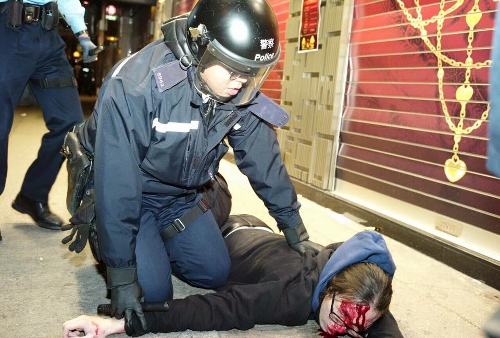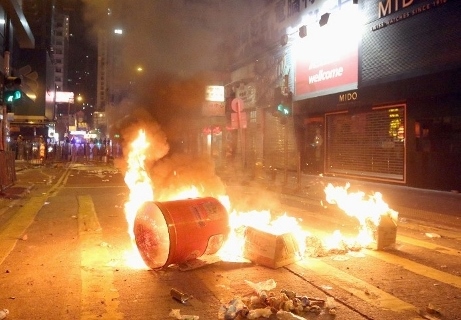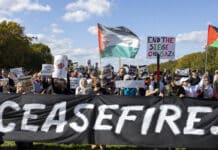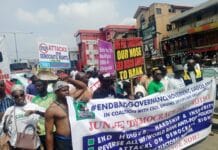Police violence must be condemned
Socialist Action eyewitness report
Brutal policing caused a riot in the downtown district of Mong Kok on the first night of the Chinese New Year, 8 February. Protesters had gathered to defend street food hawkers from a high-profile raid by law enforcement agencies. Police arrested at least 54 people during the clashes and a police spokesman said more arrests are planned. Media reports say the number of injured could exceed 120.

These events have been nicknamed the ‘Fishball Revolution’ – influenced by the mass pro-democracy ‘Umbrella Revolution’ of 2014 (Mong Kok’s main road was one of three sites occupied for almost three months in 2014). Street food hawkers (selling snacks like fishballs) have been one of the traditions of the Chinese New Year celebrations in Hong Kong, and the government had always tolerated them in the past. However, last year the government started to clamp down on these “illegal hawkers”, which triggered mass anger. This year, the government conducted even harsher raids against the street hawkers, and angry masses were mobilised in support of the hawkers. Such high-profile actions by the police showed that the police were keen to show their muscles. Due to political decisions by the government, Mong Kok became a tinderbox on New Year’s Night.
Revenge against police
At 10pm on New Year’s Day, crowds gathered in Mong Kok as officers of the Food and Hygiene Department were issuing fines to street hawkers. By 11pm, police arrived and attacked the protesters with pepper spray and batons. The tension kept mounting till 2am. Protesters were throwing objects at the police, when suddenly a policeman fired two warning shots into the air and pointed his gun at the people, which triggered further violent clashes. Police rules are very strict on the use of firearms and do not allow the firing of shots into the air as a method of warning. This action represented a new breach of rules by the police.
These events were like a reprise of the ‘Umbrella Revolution’; police pepper sprayed the crowd and many protesters were also beaten up and lying in blood. At 4am, a group of masked protesters started to dig up bricks from the road and pull down traffic signs. They also stopped nearby journalists and people from taking any photos. The protesters then threw bricks at the police and smashed the glass windows of police cars. The police responded by throwing bricks too. Demonstrators gathered in Shantung Street and Sai Yeung Choi Street and some set fire to rubbish bins. At least one taxi was also set on fire.
It is possible the New Year riots were partly instigated by pro-government thugs hidden among the people. It cannot be ruled out that police spies were at the scene ‘causing chaos’ in front of cameras. However, one thing that is certain is that the riots have gained the support of a layer of people, especially youth, being seen as a way to take revenge on the police.
The failure of the Umbrella Revolution was due to its too limited programme (partial reform rather than complete change of system) and refusal to call for solidarity protests beyond Hong Kong, especially inside China which is the decisive battlefield for the Chinese dictatorship. For a layer of youth, however, this failure has been misconstrued.
They reject the so-called “peaceful and rational” strategy of the bourgeois democratic opposition leaders (pan-democrats), but oversimplify this into the need for ‘violence’ rather than seeing that a revolutionary programme is the key. Without a political alternative, and without the ability for mass protests to escalate in a strong and organised way, some radical youths have turned to the method of rioting. This is particularly the case with some ‘nativist’ groups (a peculiar mix of far right and racist ideas with pro-independence sentiment).

Revolutionary programme
Socialist Action (CWI in Hong Kong) condemns the police violence, which is the ultimate culprit in this incident. The government and the mainstream media will make use of the riot to attack all protesters as “thugs”, and to legitimise their plans to expand police powers, and to step up repression against democratic movements.
The nativists encourage a romantic idea of “chivalrous struggle” – meaning confrontation with the police – but in fact only 20 or so members of nativist groups were present during the clashes. The mainstream media have consciously overstated their role in preparation for a government propaganda offensive against “Hong Kong independence forces”, and in order to scare people from taking part in democratic struggles.
While socialists support the right of self-defence of protests and groups in struggle, we stress this must be disciplined and organised, preferably though democratic workers’ organisations. Riots are never an effective way to fight against the establishment. This not only does not threaten the regime, but in fact gives it an excuse to reinforce its repressive machine. Socialists stand for organised mass struggles around a clear revolutionary programme to defeat dictatorial capitalism. Only this can channel the mass anger into a force to shatter the dictatorship.
Socialist Action demands an independent public enquiry into the police actions of 8-9 February. New, disciplined, mass demonstrations must be called to protest against police brutality and against the stepping up of political repression by the government. This must be the first step towards rebuilding a mass movement for full and immediate democratic rights and the overthrow of the dictatorship in China and Hong Kong.





